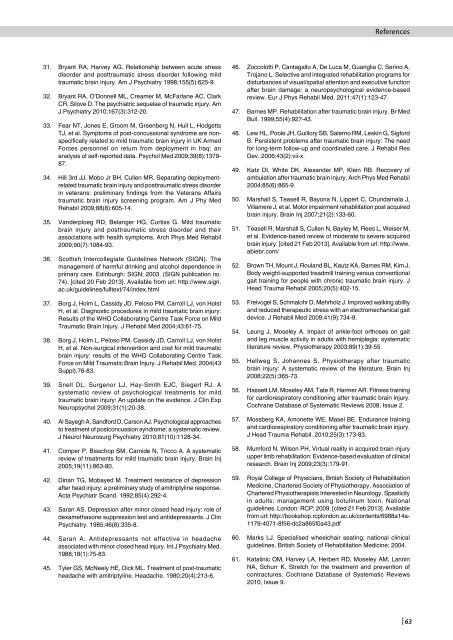sign130
sign130
sign130
Create successful ePaper yourself
Turn your PDF publications into a flip-book with our unique Google optimized e-Paper software.
31. Bryant RA, Harvey AG. Relationship between acute stress<br />
disorder and posttraumatic stress disorder following mild<br />
traumatic brain injury. Am J Psychiatry 1998;155(5):625-9.<br />
32. Bryant RA, O’Donnell ML, Creamer M, McFarlane AC, Clark<br />
CR, Silove D. The psychiatric sequelae of traumatic injury. Am<br />
J Psychiatry 2010;167(3):312-20.<br />
33. Fear NT, Jones E, Groom M, Greenberg N, Hull L, Hodgetts<br />
TJ, et al. Symptoms of post-concussional syndrome are nonspecifically<br />
related to mild traumatic brain injury in UK Armed<br />
Forces personnel on return from deployment in Iraq: an<br />
analysis of self-reported data. Psychol Med 2009;39(8):1379-<br />
87.<br />
34. Hill 3rd JJ, Mobo Jr BH, Cullen MR. Separating deploymentrelated<br />
traumatic brain injury and posttraumatic stress disorder<br />
in veterans: preliminary findings from the Veterans Affairs<br />
traumatic brain injury screening program. Am J Phy Med<br />
Rehabil 2009;88(8):605-14.<br />
35. Vanderploeg RD, Belanger HG, Curtiss G. Mild traumatic<br />
brain injury and posttraumatic stress disorder and their<br />
associations with health symptoms. Arch Phys Med Rehabil<br />
2009;90(7):1084-93.<br />
36. Scottish Intercollegiate Guidelines Network (SIGN). The<br />
management of harmful drinking and alcohol dependence in<br />
primary care. Edinburgh: SIGN; 2003. (SIGN publication no.<br />
74). [cited 20 Feb 2013]. Available from url: http://www.sign.<br />
ac.uk/guidelines/fulltext/74/index.html<br />
37. Borg J, Holm L, Cassidy JD, Peloso PM, Carroll LJ, von Holst<br />
H, et al. Diagnostic procedures in mild traumatic brain injury:<br />
Results of the WHO Collaborating Centre Task Force on Mild<br />
Traumatic Brain Injury. J Rehabil Med 2004;43:61-75.<br />
38. Borg J, Holm L, Peloso PM, Cassidy JD, Carroll LJ, von Holst<br />
H, et al. Non-surgical intervention and cost for mild traumatic<br />
brain injury: results of the WHO Collaborating Centre Task<br />
Force on Mild Traumatic Brain Injury. J Rehabil Med. 2004(43<br />
Suppl):76-83.<br />
39. Snell DL, Surgenor LJ, Hay-Smith EJC, Siegert RJ. A<br />
systematic review of psychological treatments for mild<br />
traumatic brain injury: An update on the evidence. J Clin Exp<br />
Neuropsychol 2009;31(1):20-38.<br />
40. Al Sayegh A, Sandford D, Carson AJ. Psychological approaches<br />
to treatment of postconcussion syndrome: a systematic review.<br />
J Neurol Neurosurg Psychiatry 2010;81(10):1128-34.<br />
41. Comper P, Bisschop SM, Carnide N, Tricco A. A systematic<br />
review of treatments for mild traumatic brain injury. Brain Inj<br />
2005;19(11):863-80.<br />
42. Dinan TG, Mobayed M. Treatment resistance of depression<br />
after head injury: a preliminary study of amitriptyline response.<br />
Acta Psychiatr Scand. 1992;85(4):292-4.<br />
43. Saran AS. Depression after minor closed head injury: role of<br />
dexamethasone suppression test and antidepressants. J Clin<br />
Psychiatry. 1985;46(8):335-8.<br />
44. Saran A. Antidepressants not effective in headache<br />
associated with minor closed head injury. Int J Psychiatry Med.<br />
1988;18(1):75-83.<br />
45. Tyler GS, McNeely HE, Dick ML. Treatment of post-traumatic<br />
headache with amitriptyline. Headache. 1980;20(4):213-6.<br />
References<br />
46. Zoccolotti P, Cantagallo A, De Luca M, Guariglia C, Serino A,<br />
Trojano L. Selective and integrated rehabilitation programs for<br />
disturbances of visual/spatial attention and executive function<br />
after brain damage: a neuropsychological evidence-based<br />
review. Eur J Phys Rehabil Med. 2011;47(1):123-47.<br />
47. Barnes MP. Rehabilitation after traumatic brain injury. Br Med<br />
Bull. 1999;55(4):927-43.<br />
48. Lew HL, Poole JH, Guillory SB, Salerno RM, Leskin G, Sigford<br />
B. Persistent problems after traumatic brain injury: The need<br />
for long-term follow-up and coordinated care. J Rehabil Res<br />
Dev. 2006;43(2):vii-x.<br />
49. Katz DI, White DK, Alexander MP, Klein RB. Recovery of<br />
ambulation after traumatic brain injury. Arch Phys Med Rehabil<br />
2004;85(6):865-9.<br />
50. Marshall S, Teasell R, Bayona N, Lippert C, Chundamala J,<br />
Villamere J, et al. Motor impairment rehabilitation post acquired<br />
brain injury. Brain Inj 2007;21(2):133-60.<br />
51. Teasell R, Marshall S, Cullen N, Bayley M, Rees L, Weiser M,<br />
et al. Evidence-based review of moderate to severe acquired<br />
brain injury. [cited 21 Feb 2013]. Available from url: http://www.<br />
abiebr.com/<br />
52. Brown TH, Mount J, Rouland BL, Kautz KA, Barnes RM, Kim J.<br />
Body weight-supported treadmill training versus conventional<br />
gait training for people with chronic traumatic brain injury. J<br />
Head Trauma Rehabil 2005;20(5):402-15.<br />
53. Freivogel S, Schmalohr D, Mehrholz J. Improved walking ability<br />
and reduced therapeutic stress with an electromechanical gait<br />
device. J Rehabil Med 2009;41(9):734-9.<br />
54. Leung J, Moseley A. Impact of ankle-foot orthoses on gait<br />
and leg muscle activity in adults with hemiplegia: systematic<br />
literature review. Physiotherapy 2003;89(1):39-55.<br />
55. Hellweg S, Johannes S. Physiotherapy after traumatic<br />
brain injury: A systematic review of the literature. Brain Inj<br />
2008;22(5):365-73.<br />
56. Hassett LM, Moseley AM, Tate R, Harmer AR. Fitness training<br />
for cardiorespiratory conditioning after traumatic brain injury.<br />
Cochrane Database of Systematic Reviews 2008, Issue 2.<br />
57. Mossberg KA, Amonette WE, Masel BE. Endurance training<br />
and cardiorespiratory conditioning after traumatic brain injury.<br />
J Head Trauma Rehabil. 2010;25(3):173-83.<br />
58. Mumford N, Wilson PH. Virtual reality in acquired brain injury<br />
upper limb rehabilitation: Evidence-based evaluation of clinical<br />
research. Brain Inj 2009;23(3):179-91.<br />
59. Royal College of Physicians, British Society of Rehabilitation<br />
Medicine, Chartered Society of Physiotherapy, Association of<br />
Chartered Physiotherapists Interested in Neurology. Spasticity<br />
in adults: management using botulinum toxin. National<br />
guidelines. London: RCP; 2009. [cited 21 Feb 2013]. Available<br />
from url: http://bookshop.rcplondon.ac.uk/contents/6988a14a-<br />
1179-4071-8f56-dc2a865f0a43.pdf<br />
60. Marks LJ. Specialised wheelchair seating: national clinical<br />
guidelines. British Society of Rehabilitation Medicine; 2004.<br />
61. Katalinic OM, Harvey LA, Herbert RD, Moseley AM, Lannin<br />
NA, Schurr K. Stretch for the treatment and prevention of<br />
contractures. Cochrane Database of Systematic Reviews<br />
2010, Issue 9.<br />
| 63


